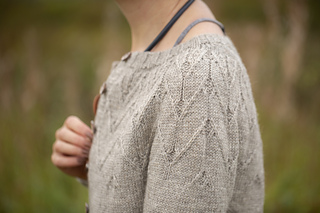patterns >  SARK and 1 more...
SARK and 1 more...
> Hirne


















Hirne
Hirne
A circular yoked cardigan, with an elegant pattern of twisted stitches across the yoke. In Scots, a hirne is a cosy nook or corner.
Yarn
Kate Davies Designs Ooskit (100% British Wool; 240yds / 220m per 100g skein)
Domra: 5 (5, 6, 6, 6, 7) 7, 7, 8, 8, 9, 9 x 100g skeins
Check sizing table for garment dimensions. Yarn quantities are calculated for a cardigan of regular length. Knitting the cropped length will use between 0.5 and 1 skein less.
Needles and Notions
Gauge-size and below gauge-size circular needles of appropriate lengths for working body, yoke, and neckline
Gauge-size and below gauge-size needle(s) of your preferred type for working small circumferences
Gauge-size dpn (for buttonholes)
Needles two sizes below gauge-size (for bands)
Stitch markers
Waste yarn for holding stitches
Tapestry needle
9-13 buttons, approx 1.5cm / ½in
Gauge
22 sts and 30 rounds to 10cm / 4in over stockinette in the round using gauge-size needle. If your gauge tends to tighten when working small circumferences, you may need to go up a needle size for sleeves. Use 4mm needle as a starting point for swatching.
Sizes
Finished bust circumference (with overlapped front bands):
90 (94, 101.5, 105.5, 110.5, 116) 119.5, 127, 136.5, 143.5, 150, 159 cm / 35½ (37, 40, 41½, 43½, 45¾) 47, 50, 53¾, 56½, 59.5, 62½ in
Select the size above your actual bust measurement with the amount of ease required. Shown in the second size.
Pattern notes
This steeked cardigan is knitted in the round, from the bottom up, all in one piece. The body is completed first, followed by the sleeves, before they are joined together and the yoke is worked from a chart, which is read from right to left throughout. After the garment is completed, steeks are cut, and front bands added.
This pattern is part of a small collection featuring motifs adapted from Norah Gaughan’s brilliant Twisted Stitch Sourcebook

350 projects
stashed
321 times
- First published: November 2021
- Page created: November 28, 2021
- Last updated: August 28, 2024 …
- visits in the last 24 hours
- visitors right now





